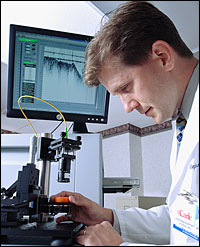
Near-IR Imaging Could Help Detect, Treat Breast Cancer
CHAMPAIGN, Ill., Sept. 14, 2006 -- A near-infrared imaging technique being developed could have a significant impact on the way doctors detect, diagnose and treat breast cancer.
Called optical coherence tomography, the new technique by researchers at the University of Illinois at Urbana-Champaign works by focusing a beam of near-infrared (near-IR) light into tissue and measuring the intensity and position of the resulting reflections. Similar in operation to ultrasound, optical coherence tomography can be used for guiding needle biopsies and for identifying tumor margins during surgery.
University of Illinois professor Stephen Boppart is leading research to develop a new near-infrared imaging technique that can be used to guide needle biopsies and for identifying tumor margins during surgery. The technique could have a significant impact in the way doctors detect, diagnose and treat breast cancer. (Photo: Carle Foundation Hospital)
"Tissue removed during biopsy or surgery must be microscopically examined by a pathologist, which can sometimes result in a lengthy and anxious wait for the patient," said Stephen Boppart, a professor of electrical and computer engineering, of bioengineering and of medicine at the U of I. "We want to move the microscopic examination of tissue from the pathology lab to the patient's point of care, and do the analysis in real time."
The adult human breast consists of two main types of tissue: fibrous tissue and fat cells. Because breast tumors are very dense, they stand out in sharp optical contrast against both types of normal breast tissue.
Pinpointing a suspicious mass from a mammogram during a needle biopsy, however, can be difficult for the doctor and painful for the patient. "What we need is a real-time imaging system to accurately guide us to the site of tissue collection," said Boppart, who also is a physician and a researcher at the Beckman Institute for Advanced Science and Technology and the Institute for Genomic Biology at the U of I. He has devised two techniques for providing image-guided needle biopsies.
Conventional biopsy needles have an outer sheath and an inner shaft tipped with pincers for snipping small pieces of tissue for pathological analysis. In his first technique, Boppart temporarily replaces the inner shaft with an optical fiber that provides optical coherence tomography imaging at the needle tip. When positioned against a suspicious mass, the fiber is withdrawn, pincers inserted and tissue specimen collected.
In his second technique, Boppart uses a specially designed biopsy needle with an integrated optical fiber and lens assembly terminating at a groove in the needle. As the needle penetrates the breast, tissue slides through the groove. By monitoring the index of refraction and other optical tissue properties, Boppart can differentiate tissue types as the needle approaches a suspicious mass. Doctors using the technique may eventually not require tissue specimens for an accurate diagnosis.
Boppart and graduate student Freddy Nguyen have also developed a portable optical coherence tomography system for use in hospital operating rooms. In collaboration with surgeons at Carle Foundation Hospital in Urbana, Ill., they have used the system to image tumor tissue immediately upon removal from the patient.
"A common concern of both doctor and patient is whether all of the tumor has been removed," Boppart said. "Optical coherence tomography can assist the surgeon by imaging the tumor margins and highlighting suspicious areas."
Imaging resected tissue at micron resolution creates enormous data sets that must be quickly acquired, analyzed and displayed. Boppart and graduate student Adam Zysk have been working on ways to increase the speed of analysis from the optical tomography system. They describe their latest computational methods in a paper accepted for publication in the Journal of Biomedical Optics.
"Our next goal is to further improve our computer-aided tissue identification algorithms," Boppart said. "Ultimately, we would like to see optical coherence tomography serve as an automated diagnostic tool for the detection of breast cancer."
The work was funded by the National Institutes of Health, the National Science Foundation, Carle Foundation Hospital and the U of I For more information, visit: www.news.uiuc.edu
Published: September 2006